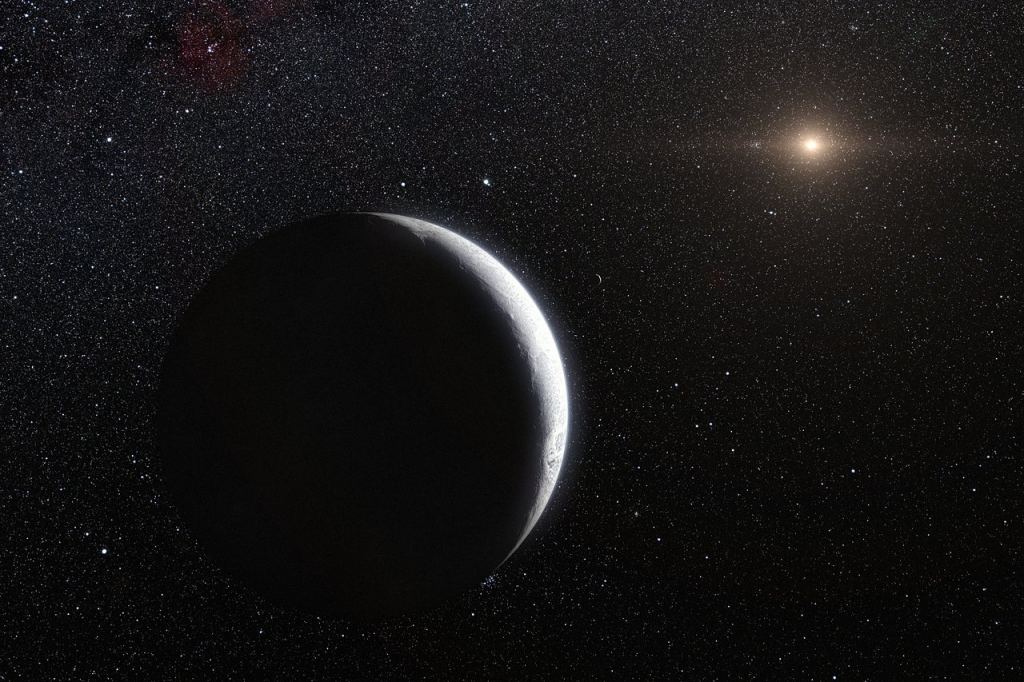In 2005, astronomer Mike Brown and his colleagues Chad Trujillo and David Rabinowitz announced the discovery of a previously unknown planetoid in the Kuiper Belt beyond Neptune’s orbit. The team named this object Eris after the Greek personification of strife and discord, which was assigned by the IAU a year later. Along with Haumea and Makemake, which they similarly observed in 2004 and 2005 (respectively), this object led to the “Great Planet Debate,” which continues to this day.
Meanwhile, astronomers have continued to study the Trans-Neptunian region to learn more about these objects. While subsequent observations have allowed astronomers to get a better idea of Eris’ size and mass, there are many unresolved questions about the structure of this “dwarf planet” and how it compares to Pluto. In a recent study , Mike Brown and University of California Santa Cruz professor Francis Nimmo presented a series of models based on new mass estimates for Eris’ moon Dysnomia .
According to their results, Eris is likely differentiated into a convecting icy shell and rocky core, which sets it apart from Pluto’s conductive shell. Their paper, “ The internal structure of Eris inferred from its spin and orbit evolution ,” recently appeared in the journal Science Advances . The research began while Nimmo was visiting Professor Brown at Caltech and realized that some of his previously-unpublished data could help reveal information about the properties of Eris.
At present, we know that Eris is about the same size and mass as Pluto and has a highly eccentric orbit around our Sun, ranging from 38. 271 AU at perihelion to 97. 457 AU at aphelion.
This is almost twice as eccentric as Pluto’s orbit and roughly 50% farther from the Sun. For several months, Brown and Nimmo worked on models of Eris that incorporated two key pieces of information. The first had to do with Eris’ only known satellite, Dysnomia, and how the two bodies always face the same way toward each other.
“That happens because the big planet gets spun down by the tides that the little moon raises on it,” said Nimmo in a recent UCSC press release . “The bigger the moon is, the faster the planet spins down. And so as soon as you know that, then you can actually start to do real calculations.
” Astronomers can use the spin and orbital characteristics of planets and their moons to infer certain properties, like their internal structures. But until recently, scientists did not have estimates on Dysnomia’s size, mass, and density. Luckily, Brown and his colleague Bryan J.
Butler – a researcher at the National Radio Astronomy Observatory (NRAO) – recently conducted observations of Dysnomia and Eris (and Orcus and its satellite Vanth) using the Atacama Large Millimeter-submillimeter Array (ALMA). Based on their findings, published in The Planetary Science Journal , Dysnomia has a diameter of about 615 km (382 mi) and Dysnomia and Eris have a mass ratio of 0. 0085.
This upper mass limit provided the second crucial piece of information, which concerned Eris’ internal structure. The main result of Brown and Nimmo’s model (but did not expect) is that Eris is surprisingly dissipative, a concept in thermodynamics where a system operates out of equilibrium. From this, they determined that Eris has a rocky core surrounded by a layer of ice and a crust that is likely convecting.
“The rock contains radioactive elements, and those produce heat,” Nimmo said. “And then that heat has to get out somehow. So as the heat escapes, it drives this slow churning in the ice.
” This sets it apart from Pluto, which has a conducting shell, as revealed by the New Horizon mission. Brown and Nimmo hope that more exact measurements of Dysnomia’s mass will be available in the near future, as well as additional data about the shape of Eris. Because of its distance, Eris appears as a single pixel of light, while Dysnomia is visible as a faint speck next to it (see below).
Therefore, astronomers must monitor Eris as it passes in front of background stars to reconstruct its shape. This is similar to the Transit Method astronomers use to detect exoplanets and constrain their sizes. As Nimmo summarized , these measurements will help he and Brown refine the models they created: “If Dysnomia is smaller than that, then Eris is even more squishy.
We make the point that Eris should be pretty smooth because if there’s any surface topography, the ice is going to flow, and that topography will go away. So it would be nice to get some measurements of what shape Eris is because if it’s very irregular, that would not agree with our model. ” “The star blinks out and then the star comes back, and that tells you how wide Eris is at that point.
And if you do that with a whole bunch of stars, then you can actually reconstruct shape. I’m hoping people are actually doing it, I just don’t know whether they are. ” Further Reading: UCSC.
From: universetoday
URL: https://www.universetoday.com/164573/eris-could-be-slushier-than-pluto/



